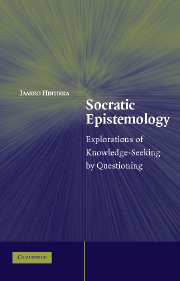Book contents
- Frontmatter
- Contents
- Acknowledgments
- Introduction
- 1 Epistemology without Knowledge and without Belief
- 2 Abduction—Inference, Conjecture, or an Answer to a Question?
- 3 A Second-Generation Epistemic Logic and its General Significance
- 4 Presuppositions and Other Limitations of Inquiry
- 5 The Place of the a priori in Epistemology
- 6 Systems of Visual Identification in Neuroscience: Lessons from Epistemic Logic
- 7 Logical Explanations
- 8 Who Has Kidnapped the Notion of Information?
- 9 A Fallacious Fallacy?
- 10 Omitting Data—Ethical or Strategic Problem?
- Index
- References
6 - Systems of Visual Identification in Neuroscience: Lessons from Epistemic Logic
Published online by Cambridge University Press: 05 June 2012
- Frontmatter
- Contents
- Acknowledgments
- Introduction
- 1 Epistemology without Knowledge and without Belief
- 2 Abduction—Inference, Conjecture, or an Answer to a Question?
- 3 A Second-Generation Epistemic Logic and its General Significance
- 4 Presuppositions and Other Limitations of Inquiry
- 5 The Place of the a priori in Epistemology
- 6 Systems of Visual Identification in Neuroscience: Lessons from Epistemic Logic
- 7 Logical Explanations
- 8 Who Has Kidnapped the Notion of Information?
- 9 A Fallacious Fallacy?
- 10 Omitting Data—Ethical or Strategic Problem?
- Index
- References
Summary
The following analysis shows how developments in epistemic logic can play a non-trivial role in cognitive neuroscience. These obtain a striking correspondence between two modes of identification, as distinguished in the epistemic context, and two cognitive systems distinguished by neuroscientific investigation of the visual system (the “where” and “what” systems). It is argued that this correspondence is not coincidental, and that it can play a clarificatory role at the actual working levels of neuroscientific theory.
Introduction
While most work in neuroscience is conducted at the cellular and sub-cellular level, brain research that catches the eye of philosophers is likely to come from a relatively recent interdisciplinary hybrid known as “cognitive neuroscience.” Explanations from cognitive neuroscience are of interest to philosophers since they offer the possibility of connecting brain and behavior through the specification of the information processing properties of parts and processes of the brain. However, despite the prominence of the information-processing approach in the brain and behavioral sciences, it is difficult to know exactly what cognitive neuroscientists mean by “information.” Historically, contexts in which this term has been given a precise definition include the so-called mathematical theory of communication, the theory of semantic information of Carnap and Bar-Hillel, and later the theories of informational complexity associated with Kolmogorov and Solomonoff. Most uses of the term “information” by cognitive scientists and neuroscientists conform to none of these three contexts.
Philosophers frequently complain of a lack of precision in scientific uses of the notion of information.
- Type
- Chapter
- Information
- Socratic EpistemologyExplorations of Knowledge-Seeking by Questioning, pp. 145 - 160Publisher: Cambridge University PressPrint publication year: 2007



